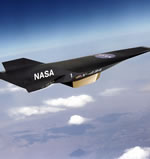
Image credit: NASA
A NASA investigation board released its findings on Wednesday that revealed why the X-34A Hyper-X prototype failed during a test on June 2, 2001. The investigators found that various miscalculations built into the prototype collectively caused the mishap. The X-34A is an experimental program to develop an air breathing hypersonic aircraft that could eventually fly up to 10 times the speed of sound. The X-34A was attached to the front of a Pegasus rocket and launched from a modified B-52 bomber. Only 13 seconds into its flight the aircraft went out of control, and was destroyed.
The NASA mishap investigation board, charged to review the loss of the X-43A Hyper-X program research vehicle during its June 2, 2001 launch, concluded no single factor or potential contributing factor caused the mishap. The flight failed because the vehicle’s control system design was deficient in several analytical modeling areas, which overestimated the system’s margins.
NASA’s Hyper-X program is developing “air breathing” engine technologies that promise performance benefits for future hypersonic aircraft and reusable space launch vehicles. In the X-43A test program, three, 12-foot long, unpiloted vehicles were planned to fly up to 10 times the speed of sound to demonstrate scramjet, or supersonic-combustion ramjet, technologies. The mishap occurred on the first of three planned flights.
For the launch, the X-43A was attached to the nose of a modified Pegasus launch vehicle, which was carried by NASA’s modified B-52 bomber. Seventy-five minutes after takeoff, at an altitude of approximately 24,000 ft., the Pegasus was released. Its solid rocket motor ignited 5.2 seconds later sending the launch vehicle and research vehicle payload on its test flight. Eight seconds later, the vehicle began its planned pitch up maneuver, which was expected to take it to an altitude of approximately 95,000 ft.
Shortly thereafter, the X-43A began to experience a control anomaly characterized by a roll oscillation. At 13.5 seconds after release and at an altitude of approximately 22,000 ft., structural overload of the starboard elevon occurred. The severe loss of control caused the X-43A to deviate significantly from its planned trajectory, and as a result, it was destroyed by range safety 48.6 seconds after release.
The mishap board found the major contributors to the mishap were modeling inaccuracies in the fin actuation system, modeling inaccuracies in the aerodynamics, and insufficient variations of modeling parameters. The flight mishap could only be reproduced when all of the modeling inaccuracies with uncertainty variations were incorporated in the analysis.
“I want to thank the Mishap Investigation Board for their comprehensive and thorough evaluation,” said Dr. Victor Lebacqz, acting Associate Administrator for NASA’s Office of Aerospace Technology. “The findings and recommendations of the board greatly enhance our opportunity for a successful second flight,” he said.
Original Source: NASA News Release
